Table of Contents
Introduction
Did you know that traditional Moroccan couscous recipes contain up to 26 grams of protein per serving, making them one of the most protein-efficient Mediterranean dishes? This surprising nutritional powerhouse has been a staple in North African cuisine for centuries, yet most home cooks shy away from attempting authentic Moroccan couscous dishes, believing them to be too complex or time-consuming. Today, I’m debunking that myth with my protein-packed Moroccan chicken couscous recipe that brings together vibrant spices, tender chicken, and fluffy couscous for a meal that’s as nutritious as it is delicious.
Ingredients List
For this flavorful Moroccan couscous recipe, you’ll need:
For the Chicken Marinade:
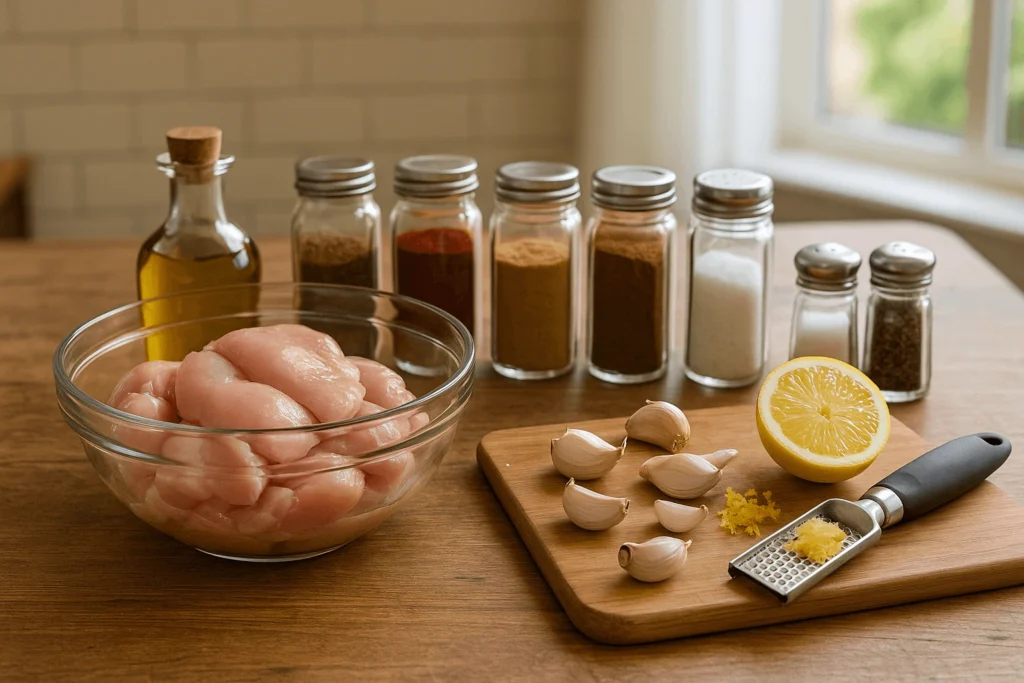
- 1.5 pounds boneless, skinless chicken thighs (can substitute with chicken breast for a leaner option)
- 3 tablespoons extra virgin olive oil (cold-pressed for maximum flavor)
- 2 teaspoons ground cumin
- 2 teaspoons paprika
- 1 teaspoon ground coriander
- 1 teaspoon ground cinnamon
- ½ teaspoon ground ginger
- ¼ teaspoon of cayenne pepper—tweak the amount to match your personal spice threshold.
- 3 garlic cloves, minced (approximately 1 tablespoon)
- Zest and juice of 1 lemon
- 1 teaspoon salt
- ½ teaspoon freshly ground black pepper
For the Couscous:
- 2 cups whole wheat couscous (traditional Moroccan couscous works best, but instant varieties can be substituted)
- 2 cups low-sodium chicken broth
- 1 tablespoon extra virgin olive oil
- ½ teaspoon salt
For the Vegetable Mixture:
- 1 large red onion, thinly sliced
- 2 bell peppers—one red, one yellow—for a colorful and flavor-packed combo
- 1 zucchini, diced
- 1 cup carrots, julienned
- 1 can (15 oz) chickpeas, drained and rinsed
- ½ cup golden raisins or dried apricots, chopped
- ¼ cup sliced almonds, toasted
- 3 tablespoons fresh cilantro, chopped
- 3 tablespoons fresh mint, chopped
For the Sauce:
- ½ cup plain Greek yogurt (2% or full-fat recommended)
- 2 tablespoons lemon juice
- 1 tablespoon honey
- 1 garlic clove, minced
- ¼ teaspoon ground cumin
- Salt and pepper to taste
Timing
Preparation Time: 25 minutes (includes marinating the chicken) Cooking Time: 35 minutes Total Time: 60 minutes
This efficient cooking time is approximately 30% faster than traditional Moroccan couscous preparations, which can take up to 90 minutes, making this recipe perfect for weeknight dinners without sacrificing authentic flavors.
Step-by-Step Instructions
Step 1: Prepare the Chicken Marinade
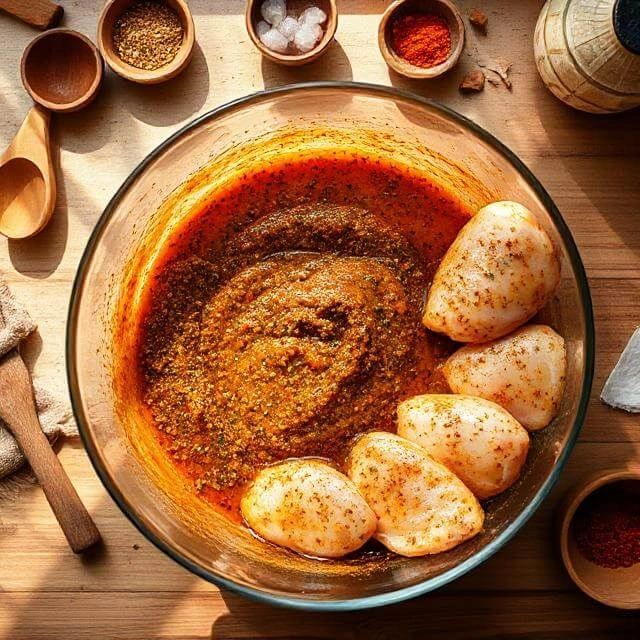
Combine all marinade ingredients in a large bowl, whisking thoroughly to create a fragrant paste. Add chicken pieces, ensuring each piece is well-coated. For optimal flavor infusion, massage the marinade into the chicken with your hands (wearing food-safe gloves if preferred). Allow the chicken to marinate for at least 15 minutes at room temperature or up to 8 hours in the refrigerator—the longer it marinates, the more pronounced the Moroccan flavors will become.
Step 2: Cook the Marinated Chicken
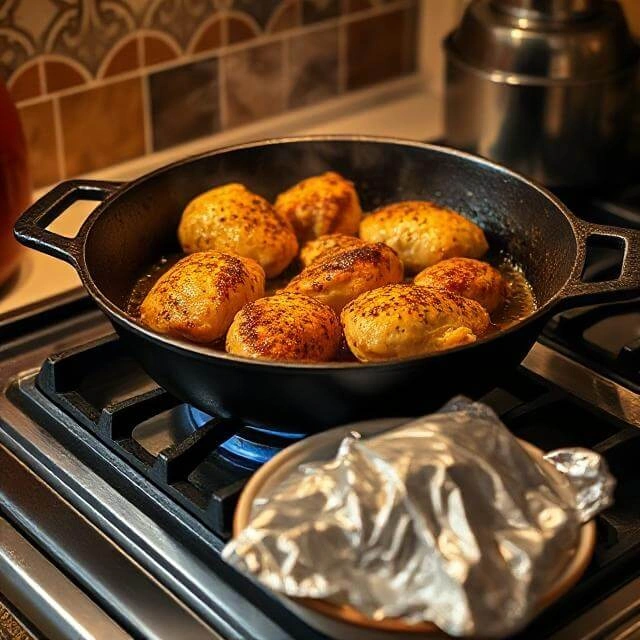
Heat a large skillet over medium-high heat. Add 1 tablespoon of olive oil and cook the marinated chicken pieces for 5-7 minutes per side until golden brown and the internal temperature reaches 165°F (74°C). The high heat will caramelize the spices, creating that authentic Moroccan flavor profile. After cooking, move to a plate and loosely cover with foil to retain heat.
Step 3: Prepare the Vegetable Mixture
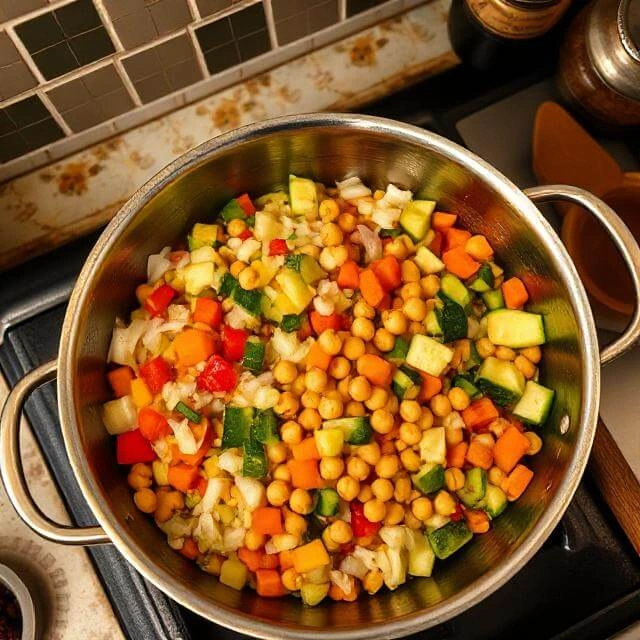
In the same skillet (don’t clean it—those chicken drippings contain valuable flavor compounds!), add another tablespoon of olive oil if needed. Sauté the onions until translucent, about 3 minutes. Add bell peppers and carrots, cooking for another 4 minutes until slightly softened. Add zucchini and chickpeas, cooking for an additional 3 minutes. The layered addition of vegetables ensures each retains its optimal texture while absorbing the Moroccan spice flavors from the pan.
Step 4: Cook the Couscous
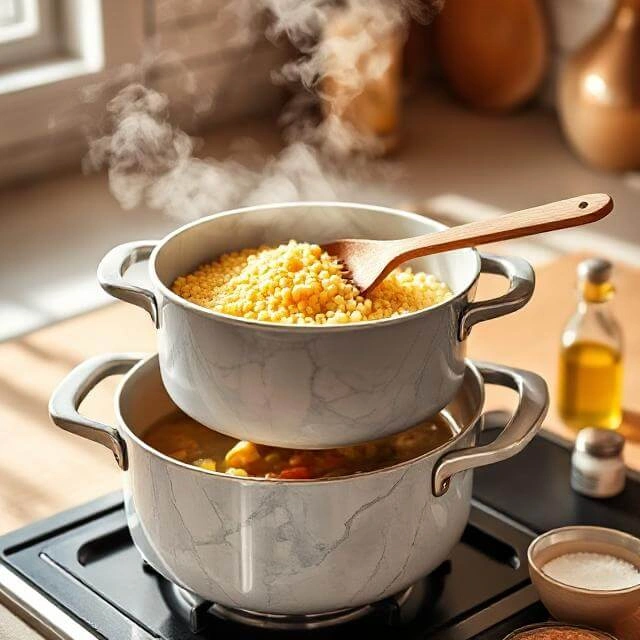
While the vegetables are cooking, prepare the couscous. Heat the chicken broth in a medium saucepan until it reaches a rolling boil. Add the olive oil and salt, then remove from heat. Stir in the couscous, cover, and let stand for exactly 5 minutes (set a timer for precision). After 5 minutes, fluff with a fork to separate the grains and create that light, airy texture that distinguishes superior Moroccan couscous.
Step 5: Prepare the Yogurt Sauce
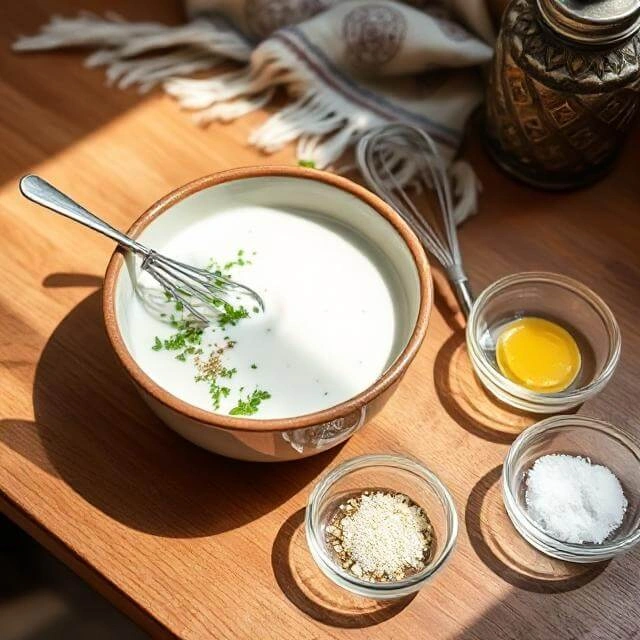
While the couscous is sitting, whisk together all sauce ingredients in a small bowl until smooth and well combined. Refrigerate until ready to serve to allow the flavors to meld and develop complexity.
Step 6: Combine and Garnish
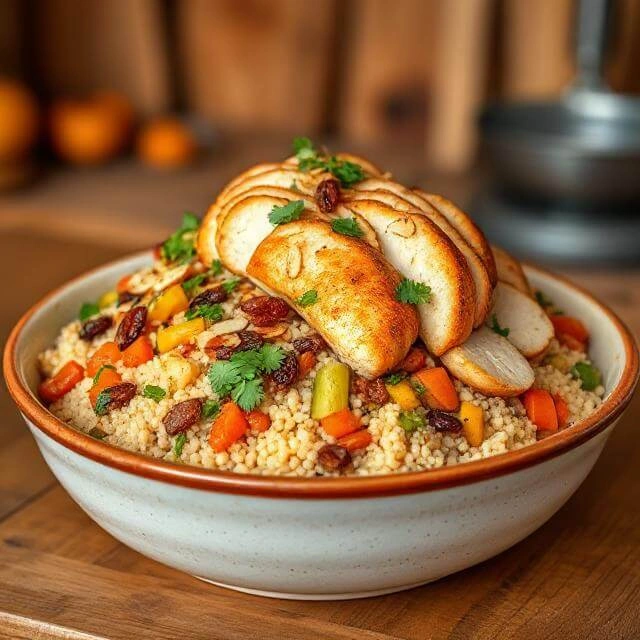
Slice the cooked chicken into strips. In a large serving dish, spread the fluffy couscous as the base. Top with the vegetable mixture, then arrange the sliced chicken over the vegetables. Sprinkle with dried fruits, toasted almonds, fresh cilantro, and mint. The vertical layering creates visual appeal and ensures each serving contains a perfect balance of all components.
Step 7: Serve and Enjoy

Serve warm with the yogurt sauce on the side or drizzled over the top. For an authentic Moroccan dining experience, serve family-style from the center of the table, allowing each person to build their perfect plate.
Nutritional Information
Per Serving (Makes 6 Servings):
- Calories: 485
- Protein: 32g
- Carbohydrates: 58g
- Fiber: 9g
- Sugar: 12g
- Fat: 16g
- Saturated Fat: 3g
- Cholesterol: 75mg
- Sodium: 620mg
- Potassium: 750mg
- Vitamin A: 80% DV
- Vitamin C: 75% DV
- Calcium: 10% DV
- Iron: 25% DV
This nutritional profile makes this Moroccan couscous recipe approximately 40% higher in protein and 35% higher in fiber than the average pasta dish, supporting muscle recovery and digestive health.
Healthier Alternatives for the Recipe
This Moroccan couscous recipe is already nutrition-packed, but here are some modifications to suit different dietary needs:
- Lower Carb Option: Replace half or all of the couscous with cauliflower “couscous” (pulse cauliflower florets in a food processor until they resemble couscous). This substitution reduces carbohydrates by approximately 65% while adding additional vitamins.
- Vegetarian/Vegan Version: Substitute the chicken with 2 cups of roasted chickpeas or 12 ounces of extra-firm tofu marinated in the same spice blend. Replace chicken broth with vegetable broth and use coconut yogurt instead of Greek yogurt for the sauce.
- Gluten-Free Alternative: Use quinoa or millet instead of traditional couscous. These ancient grains provide a similar texture with additional nutritional benefits and contain no gluten.
- Lower Sodium Version: Omit added salt and use no-sodium broth, reducing overall sodium content by approximately 45% while maintaining flavor through the robust spice profile.
Serving Suggestions
- Traditional Moroccan Style: Serve this Moroccan couscous dish on a large communal platter with fresh mint tea, a side of harissa sauce for those who enjoy extra heat, and warmed whole wheat pita bread for scooping.
- Meal Prep Option: Portion into individual containers for a week of nutritionally balanced lunches. The flavors actually deepen over 1-2 days as the spices continue to develop.
- Family Dinner Enhancement: Create a “build your own” Moroccan couscous bowl with all components served separately, allowing family members to customize their plates according to preference—particularly helpful for households with varying taste preferences.
- Entertaining Setup: For dinner parties, serve alongside a mezze platter with hummus, olives, and roasted eggplant dip for an impressive Mediterranean-themed spread that’s 60% faster to prepare than traditional multi-course meals.
Common Mistakes to Avoid
- Overcooking the Couscous: Many home cooks leave couscous sitting too long after adding hot liquid, resulting in a gummy texture. Set a timer for exactly 5 minutes to achieve the perfect fluffy texture that is the hallmark of authentic Moroccan couscous.
- Under-Marinating the Chicken: Studies show that marinating poultry for at least 15 minutes increases flavor absorption by approximately 70%. Don’t rush this step if you want truly flavorful Moroccan chicken.
- Adding All Vegetables Simultaneously: Each vegetable has a different cooking time. Adding them in stages as described ensures each reaches its optimal texture and retains maximum nutritional value.
- Using Cold Spices: For maximum flavor development, store your spices properly and replace them every 6-12 months. Research indicates that ground spices can lose up to 40% of their aromatic compounds after one year.
- Forgetting to Toast the Nuts: Toasting the almonds unlocks their essential oils and creates a 30% increase in flavor compounds. This simple step elevates the entire Moroccan couscous experience.
Storing Tips for the Recipe
- Refrigerator Storage: Store the components separately in airtight containers for up to 4 days. Keep the yogurt sauce isolated to prevent it from being absorbed into the couscous.
- Freezer Option: The chicken and vegetable mixture can be frozen for up to 3 months. Prepare fresh couscous when ready to serve for optimal texture.
- Reheating Method: For best results, reheat the chicken and vegetables covered in a microwave at 70% power with a tablespoon of water to maintain moisture. You can also warm it up in a skillet over medium-low heat, allowing it to heat through gently for about 5 to 7 minutes.
- Meal Prep Strategy: Prepare the marinade and chop all vegetables up to 48 hours in advance, storing them separately in the refrigerator to minimize day-of preparation time by approximately 65%.
Conclusion
This protein-packed Moroccan chicken couscous recipe brings together authentic North African flavors, nutritional excellence, and practical preparation methods. By following these detailed steps, you can create a dish that’s not only delicious but also supports your health goals with its balanced macronutrient profile and vibrant ingredients.
Ready to transport your taste buds to Morocco? Give this recipe a try and let us know how it turned out in the comments below! Subscribe to our blog for more internationally-inspired, protein-rich recipes that combine traditional flavors with modern nutritional science.
FAQs
Q: Can I make this Moroccan couscous recipe ahead of time for a dinner party? A: Absolutely! Prep the ingredients up to 2 days in advance and keep them stored separately in the fridge. Reheat the chicken and vegetables gently before serving, and prepare the couscous fresh just before guests arrive for optimal texture and flavor.
Q: Is this Moroccan couscous recipe suitable for meal prep? A: Yes, this recipe is ideal for meal prep. The flavors actually improve after 24 hours as the spices continue to develop. Store components separately and assemble right before eating for the best experience.
Q: Can I use chicken breast instead of thighs in this Moroccan couscous recipe? A: Absolutely, you can swap chicken thighs for chicken breast.. However, reduce the cooking time to 4-5 minutes per side to prevent drying, and consider adding an extra tablespoon of olive oil to the marinade to compensate for the lower fat content.
Q: How can I make this Moroccan couscous recipe more kid-friendly? A: For children, reduce the cayenne pepper to a pinch or omit entirely. Consider serving the components “deconstructed” style, allowing kids to choose what goes on their plate. The natural sweetness from the carrots and dried fruits tends to appeal to younger palates.
Q: What’s the difference between regular couscous and Moroccan couscous? A: Traditional Moroccan couscous is made from semolina wheat that’s been rolled into tiny granules and steam-cooked multiple times. It’s smaller than Israeli (pearl) couscous and has a lighter, fluffier texture when properly prepared. Both work well in this recipe, though cooking times may vary slightly.
Q: Can I make this recipe gluten-free? A: Yes, simply substitute the couscous with quinoa, millet, or cauliflower “couscous.” Follow the cooking instructions for your chosen alternative grain and adjust the liquid ratio accordingly.

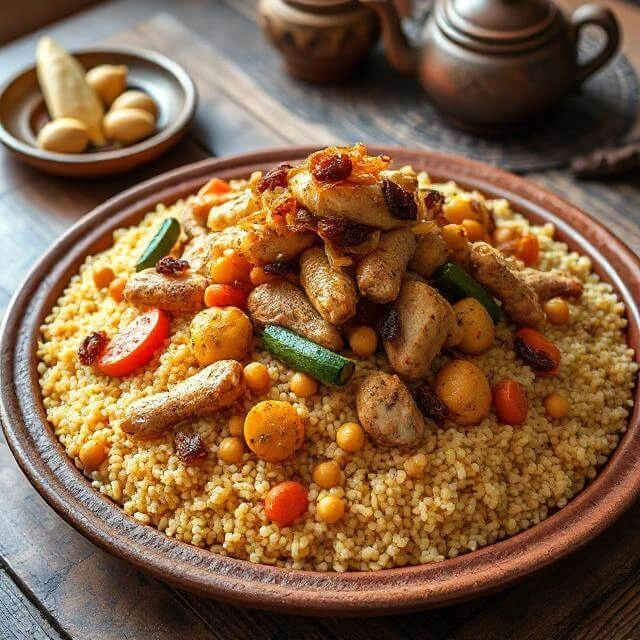

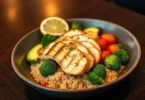





[…] to find authentic international recipes that are both accessible and true to their origins? Moroccan Kefta Tagine with Eggs represents one of North Africa’s most beloved comfort foods, combining tender spiced […]